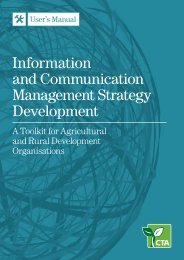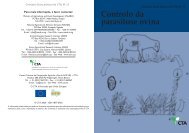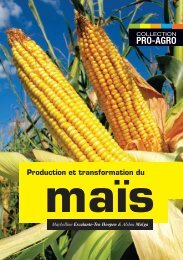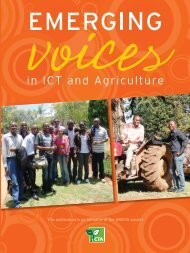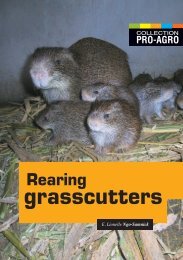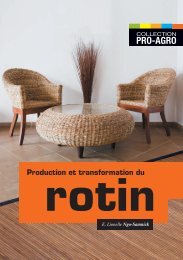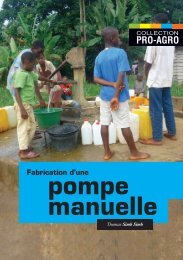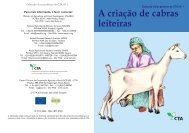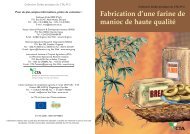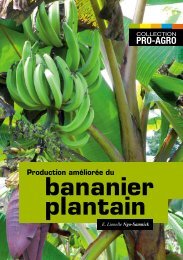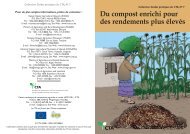Policy framework for Pastoralism in Africa
Policy framework for Pastoralism in Africa
Policy framework for Pastoralism in Africa
- No tags were found...
You also want an ePaper? Increase the reach of your titles
YUMPU automatically turns print PDFs into web optimized ePapers that Google loves.
po<strong>in</strong>ts constitutes a major source of conflicts, which are often settled through traditional conflictmanagement systems.b) Sahelian arid pastoral areaThe Sahelian arid pastoral area is a land strip located just below the southern edge of the Saharadesert. It is found <strong>in</strong> the follow<strong>in</strong>g countries from western to eastern <strong>Africa</strong>: Cape Verde, Senegal,Mauritania, Mali, Burk<strong>in</strong>a Faso, Niger, Chad, Sudan, Ethiopia and Somalia. Annual ra<strong>in</strong>fall variesfrom 150 mm to 400 mm, and temperatures are generally high (above 40°C) <strong>in</strong> the long dry andma<strong>in</strong> ra<strong>in</strong>y season, and relatively cool (below 25°C) <strong>in</strong> the short ra<strong>in</strong><strong>in</strong>g season. Water resourcesare generally scarce and vegetation is characterized by thorny shrub species and steppe-like annualgrass species. The landscape is flat often punctuated by a few hills and undulated terra<strong>in</strong>. Althoughthere is recovery of vegetation <strong>in</strong> some areas, much of the rangeland is <strong>in</strong> an advanced stage ofdegradation with limited regeneration.c) Sudano-Sahelian semi-arid pastoral areaThe semi-arid Sudano-Sahelian pastoral area of <strong>Africa</strong> lies between the southern edge of the Sahelianzone and the northern edge of the Sudanian zone. It stretches from western to eastern <strong>Africa</strong> acrossthe follow<strong>in</strong>g countries: Senegal, Mali, Burk<strong>in</strong>a Faso, Togo, Ben<strong>in</strong>, Niger and Nigeria <strong>in</strong> West <strong>Africa</strong>;Cameroon and Chad <strong>in</strong> Central <strong>Africa</strong>; and Sudan, Ethiopia, Somalia and Djibouti <strong>in</strong> East <strong>Africa</strong>.Annual ra<strong>in</strong>fall varies from 400 mm to 600 mm. This area has tropical savannah vegetation with awoody layer of deciduous trees and shrubs, and a ground layer of grass species. Pastoralists of thisarea raise various comb<strong>in</strong>ations of the follow<strong>in</strong>g livestock species: cattle, sheep, goats, horses anddonkeys. Important constra<strong>in</strong>ts to pastoral activities <strong>in</strong> the Sudano-Sahelian area <strong>in</strong>clude conflictswith settled farmers and related uncerta<strong>in</strong>ties over land ownership, and livestock diseases. Notably,pastoralists who have their home base <strong>in</strong> the Sahelian zone move their animals back and <strong>for</strong>thbetween this zone and the Sudano-Sahelian zone accord<strong>in</strong>g to the seasonal ra<strong>in</strong> distribution patternand <strong>for</strong>age availability. Parts of this zone are heavily encroached by woody plant species and weeds,which drastically reduce the productivity of the rangeland.d) Sudan and Sudano-Gu<strong>in</strong>ean sub-humid pastoral areaThe Sudan and Sudano-Gu<strong>in</strong>ean sub-humid pastoral area covers a land strip that stretches fromwestern to eastern <strong>Africa</strong> across: Senegal, Gambia, Gu<strong>in</strong>ea, southern Mali, Côte d’Ivoire, southernBurk<strong>in</strong>a Faso and central Nigeria <strong>in</strong> West <strong>Africa</strong>; northern Cameroon, southern Chad and northernCentral <strong>Africa</strong>n Republic <strong>in</strong> Central <strong>Africa</strong>; and South Sudan, southern Ethiopia, northern Kenyaand central Somalia <strong>in</strong> East <strong>Africa</strong>. Annual ra<strong>in</strong>fall ranges from 900 mm to 1200 mm. Vegetationis a tree savannah with annual grass species. High <strong>in</strong>cidences of animal diseases are major constra<strong>in</strong>tsto livestock production <strong>in</strong> this part of <strong>Africa</strong>. Use of traditionally or government demarcated graz<strong>in</strong>glands by crop farmers is a serious cause of tension between them and pastoralists, with diverseconstra<strong>in</strong>ts around security of land tenure <strong>for</strong> herders. Parts of this zone are heavily encroachedby woody plant species and weeds, which drastically reduce the productivity of the rangeland.e) Gu<strong>in</strong>ea humid pastoral areaThe Gu<strong>in</strong>ea humid pastoral area is a land strip located on the northern and southern edges of the14 <strong>Policy</strong> <strong>framework</strong> <strong>for</strong> <strong>Pastoralism</strong> <strong>in</strong> <strong>Africa</strong>




